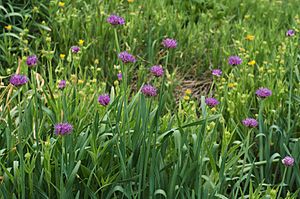Pacific mountain onion facts for kids
Quick facts for kids Pacific mountain onion |
|
|---|---|
 |
|
| Conservation status | |
| Scientific classification |
The Allium validum, often called the Pacific mountain onion, swamp onion, or wild onion, is a plant that grows in the mountains. You can find it in the Cascade Range, the Sierra Nevada, and the Rocky Mountains. It also lives in high-up areas of California, Oregon, Washington, Nevada, Idaho, and British Columbia.
What Does It Look Like?
The Pacific mountain onion has a special underground part called a bulb. This bulb is usually about three to five centimeters long. It's shaped like an egg and grows in a cluster. The outside of the bulb is covered in a brown or gray, tough layer.
This plant also has a thick underground stem called a rhizome. It helps the plant spread. The main stem of the plant grows tall, usually from 50 to 100 centimeters high. It has three to six leaves that are about the same length as the stem. These leaves are flat or slightly folded.
When it blooms, the plant has 15 to 40 flowers. Each flower is small, about six to ten millimeters long. The flower parts are usually pink to white and stand upright. The parts that hold pollen, called stamens, are longer than the flower petals.
Where Does It Grow?
This onion is very common in California. It often grows in wet, grassy areas called meadows. You can find it high up in the mountains, usually between 1,200 and 3,400 meters (about 3,900 to 11,100 feet) above sea level.
The Pacific mountain onion likes sandy and loamy soils. This means the soil should be a mix of sand, silt, and clay. It's important for the soil to drain water well, so the plant doesn't get too wet. This onion can grow in different types of soil, whether they are acidic, basic, or alkaline. But it always needs lots of moisture and sunshine to grow well.
How People Use It
The bulb of the Pacific mountain onion can be used in cooking. People sometimes add it to soups and stews to give them flavor. However, the bulb can be a bit stringy. The leaves of the plant can be eaten raw or cooked. The pretty flowers can even be used to decorate salads!
Natural Insect Repellent
This plant can also be used to keep away unwanted insects. Some people say the whole plant helps to repel insects like moths and even moles.


